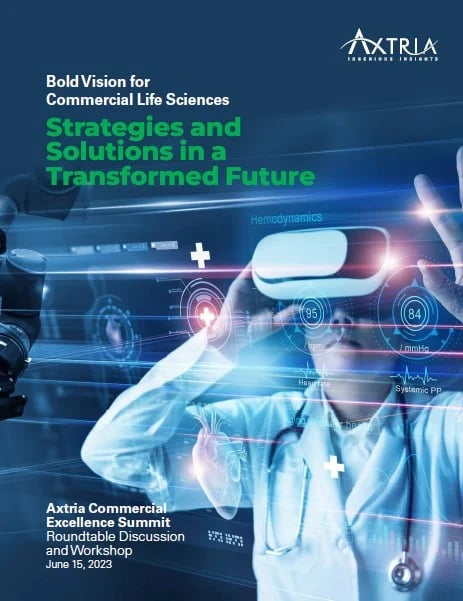The Power of Embedding Techniques and Large Language Models for Interactive Data Exploration
Vast amounts of text-based pharmaceutical data reside within formularies, research papers, clinical trial reports, and other documentation. This volume of text-based, and sometimes handwritten, data presents both a challenge and an opportunity for pharmaceutical decision-makers. Extracting actionable insights from these documents is critical for various functions of the pharmaceutical ecosystem, such as drug development, patient care, and regulatory compliance. Let’s understand with some examples.
-
Pharmaceutical formularies are comprehensive listings of medications detailing their uses, dosages, side effects, interactions, and contraindications. These documents are essential to healthcare physicians (HCPs) for making informed patient care decisions. However, it can be time-consuming and difficult to extract specific information from formularies because of the volume and complexity of the data.
-
Research papers and clinical trial reports are critical sources of scientific information. These documents provide detailed findings from scientific studies, offering insights into drug efficacy, safety profiles, and potential new therapeutic uses. The ability to synthesize this information rapidly and accurately is crucial for researchers and clinicians who must stay updated on the latest field developments.
-
Regulatory compliance is an area where the ability to process large volumes of text efficiently is vital. Agencies like the European Medicines Agency in Europe and the Food and Drug Administration in the US set strict guidelines for pharmaceutical companies. Such regulations often require the submission of extensive documentation, including detailed descriptions of drug development processes, clinical trial results, and safety data. Ensuring that all relevant information is correctly identified and presented is a difficult task that can significantly impact the approval process.
Natural language processing (NLP) and large language models (LLMs) powered by “embedding techniques” have revolutionized the way we interact with and utilize pharmaceutical data. These are now essential tools for working with complex textual data, allowing more efficient data retrieval, analysis, and reporting. They make complex data more accessible by enabling automatic extraction, interpretation, and summarization. The most remarkable feature of NLP is its ability to interpret and generate human-like text, allowing it to analyze vast databases and clinical trial reports so it can assist in identifying relevant studies and even predict potential drug interactions based on existing data.
By leveraging such technologies, pharmaceutical companies can enhance their research and development processes, improve patient care by providing more accurate and timely information to HCPs, and ensure compliance with regulatory requirements more efficiently. This article explores the role of “embedding techniques” in the evolution of LLMs and how this technology is transforming the way we interact with and utilize pharmaceutical data.
What Are Embedding Techniques?
One-hot encoding is a process used to convert categorical data variables into a form that could be provided to machine learning algorithms to do a better job in prediction1.
Embedding techniques are a cornerstone of NLP processes. These techniques are a robust method for understanding text-based data’s underlying meaning and relationships. Unlike traditional one-hot encoding approaches, embedding techniques go beyond basic dictionary definitions, capturing language’s subtle nuances and context.
This advancement from traditional encoding techniques to sophisticated embedding methods allows for a deeper understanding of the semantic connections between words and phrases. Imagine a medical researcher analyzing a vast collection of medical records. Embedding techniques allow computers to recognize the subtle variations in terminology used by different HCPs, ultimately leading to a more comprehensive analysis.
By leveraging embedding techniques, life sciences business users gain access to a more robust representation of text-based data, paving the way for significant breakthroughs in various areas, such as:
-
Enhanced medical record analysis for extracting valuable insights from vast datasets of patient data.
-
Streamlined scientific research to facilitate better comprehension of complex research papers.
-
Development of intelligent software tools that empower the creation of software that can better understand and respond to the specific needs of the life sciences industry.
Embedding techniques empower systems to grasp the true meaning behind the words used in medical documents, enabling refined data-driven decision-making.
Transformer models fundamentally changed NLP technologies by enabling models to handle long-range dependencies in text2.
The introduction of transformer architecture in 20173 marked a significant breakthrough in NLP. Unlike previous models that relied on recurrent and convolutional layers, transformers use a self-attention mechanism, enabling LLMs to consider the entire context of a sentence simultaneously. Models like Bidirectional Encoder Representations from Transformers (BERT), Generative Pre-trained Transformers (GPT), and their successors have demonstrated the unparalleled power of transformers in capturing intricate language patterns.
Embedding techniques work synergistically with the pre-training and fine-tuning strategies employed in LLMs. Pre-training involves using a massive corpus (dataset) to train an AI model in general language patterns. Fine-tuning then tailors the model to specific tasks or domains. This two-step process ensures that LLMs inherit a vast knowledge of language so they can adapt to specific requirements, making them versatile and capable of being used across diverse applications.
The evolution of LLMs, fueled by embedding techniques, has had a pervasive impact on various industries. From chatbots and virtual assistants to sentiment analysis and content creation, LLMs are transforming human-machine interaction. Their ability to understand context, generate clear and consistent text, and perform complex language tasks makes them indispensable in today’s data-driven world.
Using LLMS in the Pharmaceutical World: Indexing for Question and Answer (Q&A) Systems
Pharmaceutical formularies contain crucial information about medications, their uses, dosages, and interactions. Extracting actionable insights from these documents can be challenging, particularly in the context of Q&A systems like chatbots. Various indexing approaches are employed to address this challenge, each with its strengths and weaknesses:
- Keyword-based indexing
- Semantic indexing
- Named Entity Recognition (NER) indexing
- Concept-Based indexing
- Hybrid approaches
While exploring indexing approaches for Q&A in the pharmaceutical formulary domain, the advanced analytics team at Axtria conducted a comparative analysis to identify the most effective method. We evaluated each approach based on retrieval accuracy, computational efficiency, and scalability. After rigorous testing, we found that a hybrid approach combining semantic indexing with NER proved the most effective. By leveraging semantic analysis, the system could capture the contextual nuances of queries and documents, enhancing the relevance of retrieved information. Additionally, integrating NER ensured that crucial entities such as drug names and dosages were accurately identified and indexed, further refining the retrieval process.
Challenges and Ethical Considerations
Despite the effectiveness of embedding techniques and LLMs, challenges persist. Issues related to bias, fairness, and the responsible use of language models underscore the need for continued research and development. Balancing innovation with ethical use is critical to the ongoing development of these technologies.
The evolution of LLMs is proof of the transformative power of embedding techniques. From the early days of word embeddings to the highly developed architectures of modern transformers, these techniques have elevated language models to new heights. As the pharmaceutical marketplace continues to evolve, we must refine and adapt these sophisticated indexing strategies. Only by responsibly developing and deploying LLMs can we shape human-machine interactions that extract actionable insights capable of improving patient lives.
References
- DeepAI.org. What is One Hot Encoding? Accessed May 31, 2024. https://deepai.org/machine-learning-glossary-and-terms/one-hot-encoding
- AWS. What are transformers in artificial intelligence? Accessed May 31, 2024. https://aws.amazon.com/what-is/transformers-in-artificial-intelligence/#:~:text=Transformers%20are%20a%20type%20of,tracking%20relationships%20between%20sequence%20components.
- 3. Cornell University. Attention Is All You Need. Ashish Vaswani, Noam Shazeer, Niki Parmar, Jakob Uszkoreit, Llion Jones, Aidan N. Gomez, Lukasz Kaiser, Illia Polosukhin. June 12, 2017. Accessed May 31, 2024. https://arxiv.org/abs/1706.03762
Author details

Gope Biswas
Gope Biswas is a Director, Data Science practice at Axtria. He has over 18 years of work experience in engineering and analytics. Gope brings hands-on expertise in handling MLOps practices, ML engineering, and application integration and development.

Suraj Gupta
Suraj Gupta is a Senior Manager, Marketing at Axtria. He has over 9 years of experience in the analytics and consulting industry, with more than 6 years with life sciences. At Axtria, Suraj has contributed to sales and marketing functions, including business and client development, knowledge management, digital marketing, business intelligence, and content writing. Suraj has an MBA degree in Marketing and a graduate degree in Economics.




